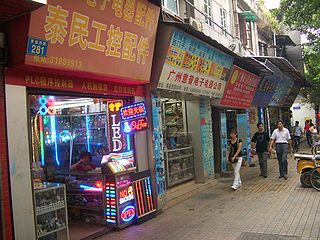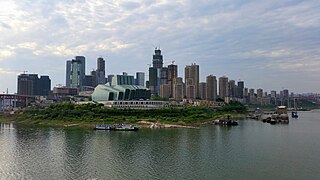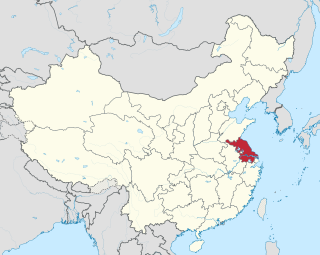
Special economic zones of China (SEZs) are special economic zones located in mainland China. The government of China gives SEZs special economic policies and flexible governmental measures, compared to the more planned economy of most of China. This allows SEZs to utilize an economic management system that is more attractive for foreign and domestic firms to do business in than the rest of mainland China. In SEZs, "...foreign and domestic trade and investment are conducted without the authorization of the Chinese central government in Beijing." SEZs offer "tax and business incentives to attract foreign investment and technology".

Duty-free shops are retail outlets that are exempt from the payment of certain local or national taxes and duties, on the requirement that the goods sold will be sold to travelers who will take them out of the country. Which products can be sold duty-free vary by jurisdiction, as well as how they can be sold, and the process of calculating the duty or refunding the duty component.

Yantian District is one of the nine districts of the city of Shenzhen, Guangdong, China. It is adjacent to Shenzhen River and Hong Kong to the south, and is surrounded by Luohu, Longgang and Pingshan districts of Shenzhen.

Tsagaannuur is a sum (district) of Bayan-Ölgii Province in western Mongolia. It is primarily inhabited by ethnic Kazakhs.
The eastern seaboard of Thailand, more frequently known as the "Eastern Economic Corridor" (EEC), is a developing economic region which plays a key role in Thailand's economy. It is Thailand's center for export-oriented industries. High value goods, such as Japanese branded automobiles, which are manufactured there and shipped elsewhere, are among the many exports. The region includes Chonburi Province, Chachoengsao Province, and Rayong Province with Samut Prakan Province on the periphery.
Trade is a key factor of the economy of China. In the twenty-five years that followed after the Communist takeover in 1949, China's trade institutions developed into a partially modern but somewhat inefficient system. The drive to modernize the economy that began in 1978 required a sharp acceleration in commodity flows and greatly improved efficiency in economic transactions. In the ensuing years economic reforms were adopted by the government to develop a socialist market economy. This type of economy combined central planning with market mechanisms. The changes resulted in the decentralization and expansion of domestic and foreign trade institutions, as well as a greatly enlarged role for free markets in the distribution of goods, and a prominent role for foreign trade and investment in economic development.
The Pearl River Delta Economic Zone, is in the Pearl River Delta region, the expansive delta lands of the Pearl River at the South China Sea. It consists of Guangzhou, Shenzhen, Zhuhai, Foshan, Dongguan, Zhongshan, Jiangmen, and parts of Huizhou and Zhaoqing, has been the most economically dynamic region of the Chinese Mainland since the launch of China's reform programme in 1979. Adjacent Hong Kong and Macau are not part of the economic zone.

The Economy of Guangdong is one of the most prosperous in China. Guangdong is located in southern China, bordering on Fujian Province to the east, Hunan Province to the north, Guangxi Autonomous Region to the west and the special administrative regions of Hong Kong and Macau to the south. It is also the largest economy of a sub-national entity in terms of GDP US$ 1.22 trillion in all of Asia, save for Greater Tokyo Area and sixth or seventh largest sub-national entity in the world.

Liangjiang, officially known as Liangjiang New Area is a state-level new area situated in the municipality of Chongqing, China. The area covers 1,205 square kilometres combining part of Jiangbei District, Yubei District, and Beibei District.
The United States imposes tariffs on imports of goods. The duty is levied at the time of import and is paid by the importer of record. Customs duties vary by country of origin and product. Goods from many countries are exempt from duty under various trade agreements. Certain types of goods are exempt from duty regardless of source. Customs rules differ from other import restrictions. Failure to properly comply with customs rules can result in seizure of goods and criminal penalties against involved parties. The United States Customs and Border Protection (“CBP”) enforces customs rules.

Shanghai Free-Trade Zone, officially China (Shanghai) Pilot Free-Trade Zone is a free-trade zone in Shanghai, China. On 22 August 2013, the State Council approved the establishment of SFTZ. Officially launched on 29 September 2013 with the backing of Chinese Premier Li Keqiang, it is the first free-trade zone in mainland China. The zone covers an area of 120.72 square kilometres (46.61 sq mi) and integrates four existing bonded zones in the district of Pudong — Waigaoqiao Free Trade Zone, Waigaoqiao Free Trade Logistics Park, Yangshan Free Trade Port Area and Pudong Airport Comprehensive Free Trade Zone. Since 21 April 2015, Shanghai FTZ's areas are expanded, including Lujiazui Financial and Trade Zone, Shanghai Jinqiao Economic and Technological Development Zone and Zhangjiang Hi-Tech Park.
The Intergovernmental Agreement on Dry Ports is a 2013 United Nations treaty designed to promote the cooperation of the development of dry ports in the Asia-Pacific region. It was concluded under the auspices of the United Nations Economic and Social Commission for Asia and the Pacific (UNESCAP) and is open to ratification by any state that is a UNESCAP member.

Philippine Economic Zone Authority (PEZA) is a government agency in the Philippines attached to the Department of Trade and Industry created to help promote investments in the export-oriented manufacturing industry into the country by assisting investors in registering and facilitating their business operations and providing tax incentives. PEZA also assists investors who locate in service facilities inside selected areas in the country which are usually business process outsourcing and knowledge process outsourcing firms. Other activities also eligible for PEZA registration and incentives include establishment and operation within special economic zones for tourism, medical tourism, logistics and warehousing services, economic zone development and operation and facilities providers.











